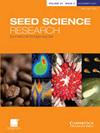种子休眠种类的巨大多样性——对Nikolaeva–Baskin初级种子休眠分类系统的修订
IF 1.9
3区 生物学
Q2 PLANT SCIENCES
引用次数: 31
摘要
摘要本文将Nikolaeva和Baskin、Baskin三种方法相结合,提出了一种改进和扩展的全种子初级休眠分类词公式系统。值得注意的变化包括以下内容。(1)分类层次中的命名层(层)从3个增加到7个。(2)已知的休眠种类给出了公式。(3)划分了7个形态休眠亚类:异养菌、全寄生菌和自养菌的“尘埃种子”;手掌的一簇簇;而隐秘发芽的种子对这个系统来说是新的。(4)水平非深度生理休眠(PD)分为两个亚级,每个亚级包含三种类型,其中6型是该系统的新成员。(5) PD纲中增加了上胚轴型PD亚纲,有两级,每级有三种类型。(6)水平深(常规)PD分为两种类型。(7)形态生理休眠(MPD)类的简单和复杂水平已扩展到12个亚类、24个水平和16个类型。(8)增加了4种类型的非深部单纯上胚轴MPD。(9)深部单纯规则上胚轴MPD分为4种类型。(10)级深简易双MPD分为两种类型。(11)种子有不透水的种皮,萌芽后胚吸器在其中生长(美人蕉),已加入组合休眠类。初级种子休眠的等级划分,突出了其在整个种子水平上的多样性和复杂性,这可以用休眠公式最准确地表达出来。本文章由计算机程序翻译,如有差异,请以英文原文为准。
The great diversity in kinds of seed dormancy: a revision of the Nikolaeva–Baskin classification system for primary seed dormancy
Abstract This review provides a revised and expanded word-formula system of whole-seed primary dormancy classification that integrates the scheme of Nikolaeva with that of Baskin and Baskin. Notable changes include the following. (1) The number of named tiers (layers) in the classification hierarchy is increased from three to seven. (2) Formulae are provided for the known kinds of dormancy. (3) Seven subclasses of class morphological dormancy are designated: ‘dust seeds’ of mycoheterotrophs, holoparasites and autotrophs; diaspores of palms; and seeds with cryptogeal germination are new to the system. (4) Level non-deep physiological dormancy (PD) has been divided into two sublevels, each containing three types, and Type 6 is new to the system. (5) Subclass epicotyl PD with two levels, each with three types, has been added to class PD. (6) Level deep (regular) PD is divided into two types. (7) The simple and complex levels of class morphophysiological dormancy (MPD) have been expanded to 12 subclasses, 24 levels and 16 types. (8) Level non-deep simple epicotyl MPD with four types is added to the system. (9) Level deep simple regular epicotyl MPD is divided into four types. (10) Level deep simple double MPD is divided into two types. (11) Seeds with a water-impermeable seed coat in which the embryo-haustorium grows after germination (Canna) has been added to the class combinational dormancy. The hierarchical division of primary seed dormancy into many distinct categories highlights its great diversity and complexity at the whole-seed level, which can be expressed most accurately by dormancy formulae.
求助全文
通过发布文献求助,成功后即可免费获取论文全文。
去求助
来源期刊

Seed Science Research
生物-植物科学
CiteScore
3.60
自引率
4.80%
发文量
23
审稿时长
>12 weeks
期刊介绍:
Seed Science Research, the official journal of the International Society for Seed Science, is a leading international journal featuring high-quality original papers and review articles on the fundamental aspects of seed science, reviewed by internationally distinguished editors. The emphasis is on the physiology, biochemistry, molecular biology and ecology of seeds.
 求助内容:
求助内容: 应助结果提醒方式:
应助结果提醒方式:


